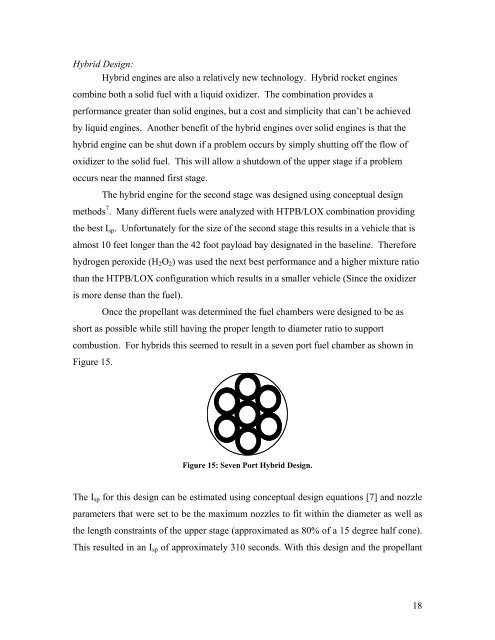Responsive Access Small Cargo Affordable Launch (RASCAL ...
Responsive Access Small Cargo Affordable Launch (RASCAL ...
Responsive Access Small Cargo Affordable Launch (RASCAL ...
Create successful ePaper yourself
Turn your PDF publications into a flip-book with our unique Google optimized e-Paper software.
Hybrid Design:<br />
Hybrid engines are also a relatively new technology. Hybrid rocket engines<br />
combine both a solid fuel with a liquid oxidizer. The combination provides a<br />
performance greater than solid engines, but a cost and simplicity that can’t be achieved<br />
by liquid engines. Another benefit of the hybrid engines over solid engines is that the<br />
hybrid engine can be shut down if a problem occurs by simply shutting off the flow of<br />
oxidizer to the solid fuel. This will allow a shutdown of the upper stage if a problem<br />
occurs near the manned first stage.<br />
The hybrid engine for the second stage was designed using conceptual design<br />
methods 7 . Many different fuels were analyzed with HTPB/LOX combination providing<br />
the best Isp. Unfortunately for the size of the second stage this results in a vehicle that is<br />
almost 10 feet longer than the 42 foot payload bay designated in the baseline. Therefore<br />
hydrogen peroxide (H2O2) was used the next best performance and a higher mixture ratio<br />
than the HTPB/LOX configuration which results in a smaller vehicle (Since the oxidizer<br />
is more dense than the fuel).<br />
Once the propellant was determined the fuel chambers were designed to be as<br />
short as possible while still having the proper length to diameter ratio to support<br />
combustion. For hybrids this seemed to result in a seven port fuel chamber as shown in<br />
Figure 15.<br />
Figure 15: Seven Port Hybrid Design.<br />
The Isp for this design can be estimated using conceptual design equations [7] and nozzle<br />
parameters that were set to be the maximum nozzles to fit within the diameter as well as<br />
the length constraints of the upper stage (approximated as 80% of a 15 degree half cone).<br />
This resulted in an Isp of approximately 310 seconds. With this design and the propellant<br />
18

















